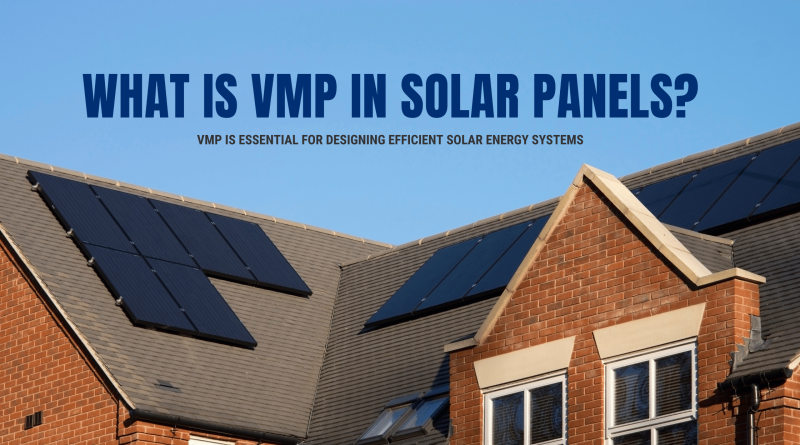What is VMP in Solar Panels?
Solar energy systems rely on various factors to optimize performance, with Voltage at Maximum Power (Vmp) being one of the crucial parameters. Vmp is the voltage at which a solar panel produces its maximum power output. Understanding Vmp is essential for designing efficient solar energy systems, ensuring compatibility with inverters and batteries, and maximizing overall energy yield. This guide delves into the concept of Vmp, its importance, and how to optimize it for the best solar panel performance.
Table of Contents
The Basics of Vmp
Vmp, or Voltage at Maximum Power, represents the voltage at which a solar panel generates its highest power output. This value is typically found on the solar panel’s datasheet and is a critical factor in determining the panel’s performance. Vmp is determined by the interaction of the panel’s current (I) and voltage (V) characteristics, specifically at the point where the product of these two variables (P = IV) is maximized.
The Relationship Between Vmp, Imp, and Pmax
1. Vmp (Voltage at Maximum Power): The voltage at which the solar panel produces its maximum power.
2. Imp (Current at Maximum Power): The current at which the solar panel produces its maximum power.
3. Pmax (Maximum Power): The maximum power output of the solar panel, calculated as Pmax = Vmp * Imp.
For instance, if a solar panel has a Vmp of 30V and an Imp of 8A, its Pmax would be 240W. This relationship highlights the importance of both voltage and current in achieving optimal power output.
The Impact of Vmp on Solar Panel Efficiency
The efficiency of a solar panel is significantly influenced by its Vmp. Efficiency is a measure of how effectively the panel converts sunlight into electrical energy. The I-V curve of a solar panel illustrates the relationship between current and voltage, and Vmp is the point where this curve intersects with the maximum power point (MPP).
- I-V Curve: The graph depicting the current (I) versus voltage (V) characteristics of a solar panel.
- Maximum Power Point (MPP): The point on the I-V curve where the product of current and voltage is highest, representing the optimal operating condition for the solar panel.
When a solar panel operates at Vmp, it is working at its most efficient point, converting the maximum amount of sunlight into usable electrical energy. Deviations from Vmp, due to factors such as temperature changes or shading, can lead to suboptimal performance and reduced efficiency.
Matching Vmp to Inverter and Battery Requirements
Matching the Vmp of a solar panel to the requirements of inverters and batteries is crucial for system efficiency and longevity. Inverters, which convert DC power generated by solar panels into AC power used by most electrical devices, have specific voltage input ranges. Ensuring that the Vmp of the solar panels falls within this range is essential for optimal inverter performance.
Inverter Specifications: Inverters have a specified input voltage range that must be matched with the Vmp of the solar panels to ensure efficient conversion.
Battery Charging: For solar systems with battery storage, Vmp plays a key role in charging efficiency. Batteries have specific voltage requirements for charging, and aligning Vmp with these requirements ensures efficient and safe battery charging.
Tips for Matching Vmp:
1. Check Inverter Datasheets: Always refer to the inverter’s datasheet to find its input voltage range and ensure that the Vmp of the solar panels falls within this range.
2. Battery Specifications: When using batteries, ensure that the Vmp matches the charging voltage requirements of the battery to avoid undercharging or overcharging.
3. System Design: During the system design phase, select solar panels with Vmp values that align with the components’ voltage requirements for maximum efficiency.
The Role of Vmp in Solar Panel Sizing
Proper solar panel sizing is essential for creating efficient solar energy systems. Vmp is a critical parameter in this process, ensuring that the panels can effectively meet the system’s power requirements.
System Design: When designing a solar system, engineers must ensure that the total Vmp of the combined panels matches the system’s voltage requirements. Incorrect sizing can lead to inefficiencies and potential system failures.
Series and Parallel Connections: The configuration of solar panels (series or parallel) affects the overall Vmp of the system. In series connections, Vmp values add up, while in parallel connections, Vmp remains the same but current increases.
Case Studies: Real-world examples demonstrate how proper Vmp matching can optimize system performance and prevent issues such as inverter overload or insufficient battery charging.
Factors Affecting Vmp
Several factors can influence the Vmp of a solar panel, affecting its performance and efficiency. Understanding these factors is crucial for optimizing solar energy systems.
Temperature:
Impact: Higher temperatures generally decrease Vmp, while lower temperatures increase it. This is due to the temperature coefficient of the solar cells.
Mitigation: Use cooling mechanisms such as proper ventilation, and install panels with a sufficient gap from the roof surface to allow airflow.
Solar Irradiance:
Impact: Variations in sunlight intensity (irradiance) can affect Vmp. Higher irradiance typically increases Vmp, while lower irradiance decreases it.
Mitigation: Position panels to maximize sun exposure, use tracking systems to follow the sun’s movement, and avoid shading.
Panel Type:
Monocrystalline Panels: Typically have higher Vmp values and are more efficient, especially in limited space.
Polycrystalline Panels: Generally have slightly lower Vmp values but are cost-effective for larger installations.
Thin-Film Panels: Vmp values vary widely; these panels are flexible and suitable for specific applications despite generally lower efficiency.
Mitigating the Impact of External Factors on Vmp
Maintaining optimal Vmp under varying conditions is crucial for the consistent performance of a solar energy system. Here are some practical tips:
Cooling Techniques: Implement passive cooling strategies such as proper spacing and ventilation. Active cooling systems, like water or air cooling, can be used in high-temperature regions.
Maximize Sun Exposure: Install panels in locations with minimal shading and optimal sun exposure. Use solar trackers to adjust panel angles throughout the day.
Regular Maintenance: Clean panels regularly to remove dust and debris that can block sunlight and affect Vmp.
Advanced Technologies: Utilize Maximum Power Point Tracking (MPPT) inverters and charge controllers to automatically adjust the operating point and maintain optimal Vmp.
Measuring and Monitoring Vmp for System Optimization
Accurate measurement and monitoring of Vmp are essential for optimizing solar panel performance and ensuring maximum energy output.
Tools for Measurement: Use multimeters, IV curve tracers, and solar power meters to measure Vmp accurately.
Monitoring Systems: Implement monitoring systems that continuously track Vmp, allowing for real-time adjustments and performance optimization.
Regular Monitoring: Schedule regular check-ups to ensure Vmp remains within optimal ranges and to identify any issues early.
Strategies for Optimization:
1. MPPT Technology: Use MPPT charge controllers and inverters to automatically find and maintain the optimal Vmp.
2. Data Analysis: Analyze historical data to identify patterns and adjust the system for better performance.
3. System Upgrades: Upgrade components like inverters or add cooling mechanisms to enhance Vmp performance.
Understanding Vmp (Voltage at Maximum Power) in Solar Panels
The Importance of Vmp in Different Solar Panel Technologies
The Voltage at Maximum Power (Vmp) varies across different solar panel technologies. Understanding these variations can help in selecting the right panel type for specific applications.
1. Monocrystalline Panels: Known for their high efficiency and higher Vmp values. They are ideal for installations with limited space, as they provide more power per square foot.
2. Polycrystalline Panels: These panels generally have slightly lower Vmp values and efficiency compared to monocrystalline panels but are more cost-effective, making them suitable for larger installations where space is not a constraint.
3. Thin-Film Panels: These panels have the widest range of Vmp values and are typically less efficient than crystalline panels. However, their flexibility and lighter weight make them suitable for certain applications, such as on curved surfaces or lightweight structures.
Vmp Comparison of Different Solar Panel Technologies
| Technology | Average Vmp (V) | Average Efficiency (%) | Ideal Use Cases |
|---|---|---|---|
| Monocrystalline | 30-40 | 18-22 | Limited space, high efficiency needed |
| Polycrystalline | 25-35 | 15-18 | Cost-effective, larger installations |
| Thin-Film | 15-25 | 10-12 | Flexible applications, weight-sensitive structures |
Practical Tips for Optimizing Vmp
To maximize energy output from your solar panels, consider the following practical tips for optimizing Vmp:
1. Proper Installation:
Orientation and Tilt: Ensure panels are oriented and tilted to capture maximum sunlight. The angle should be adjusted based on geographic location and seasonal changes.
Avoid Shading: Install panels in areas free from shading by trees, buildings, or other obstructions throughout the day.
2. Maintenance Practices:
Regular Cleaning: Clean the panels regularly to remove dust, dirt, and debris that can block sunlight and reduce Vmp.
Inspection: Perform routine inspections to check for any damage or wear and tear that could affect performance.
3. Use of MPPT Technology:
MPPT Controllers: Implement Maximum Power Point Tracking (MPPT) charge controllers and inverters to ensure the system always operates at the optimal Vmp.
Real-Time Adjustments: MPPT technology continuously adjusts the operating point to maximize power output despite changing conditions.
4. Environmental Considerations:
Temperature Control: Install panels with adequate spacing to promote airflow and reduce temperature impacts. Consider passive or active cooling systems in hot climates.
Irradiance Management: Use tracking systems to adjust the panel angle throughout the day, maximizing exposure to sunlight.
5. Component Compatibility:
Inverter Matching: Ensure the inverter’s input voltage range matches the Vmp of the solar panels for efficient energy conversion.
Battery Selection: Choose batteries with charging voltage requirements that align with the Vmp of the solar panels to ensure efficient charging.
Conclusion
Understanding and optimizing Vmp (Voltage at Maximum Power) is crucial for the performance and efficiency of solar panels. By selecting the right panel technology, matching Vmp to system components, and employing best practices for installation and maintenance, you can maximize energy output and ensure the long-term success of your solar energy system. Regular monitoring and the use of advanced technologies like MPPT can further enhance system performance, adapting to changing conditions and maintaining optimal Vmp.
Here at SolarClue®, we offer a smart, practical, and “beautiful” solution. You will be answered for all the questions related to Solar.
We provide all kinds of brands that are the Best Solar panels in India.
If you are the one who is planning for the solar power system. Don’t hesitate to contact our team!
Looking forward to empowering you with solar energy, just like hundreds of our other clients!
FAQs
1. What is Vmp and why is it important?
Vmp, or Voltage at Maximum Power, is the voltage at which a solar panel produces its maximum power. It is crucial for determining the panel’s efficiency and ensuring compatibility with other system components like inverters and batteries.
2. How does temperature affect Vmp?
Temperature variations can significantly impact Vmp. Higher temperatures typically decrease Vmp, while lower temperatures increase it. Proper cooling mechanisms and installation practices can mitigate these effects.
3. Can Vmp be optimized for better performance?
Yes, Vmp can be optimized through proper installation, regular maintenance, and the use of MPPT technology, which adjusts the operating point to maximize power output.
4. What is the difference between Vmp and Voc (Open Circuit Voltage)?
Vmp is the voltage at which a solar panel produces its maximum power, while Voc (Open Circuit Voltage) is the maximum voltage a solar panel can produce when not connected to any load. Moreover, Voc is always higher than Vmp.
5. How do I choose the right inverter based on Vmp?
To choose the right inverter, ensure its input voltage range matches the Vmp of the solar panels. This ensures efficient energy conversion and optimal system performance.


